REFERENCES
BirdLife International 2004 - Threatened Birds of the World 2004 CD-Rom.
Brooks TM, Tobias J, Balmford A 1999 - Deforestation and Bird Extinctions in the Atlantic Forest - Animal Conservation 2: p211-222.
Clay RP, del Castillo H 2004 - Annotated Checklist of the Birds of Paraguay - Guyra Paraguay.
Foster M (unpublished) - A List of the Birds of Hotel El Tirol
Galindo-Leal C, Camara IG 2003 - The Atlantic Forest of South America: Biodiversity Status, Threats and Outlook - Island Press.
Hayes FE 1995 - Status, Distribution and Biogeography of the Birds of Paraguay - American Birding Association.
Madroño A, Clay RP, Robbins MB, Rice NH, Faucett RC, Lowen JC 1997 - An Avifaunal Survey of the Vanishing Interior Atlantic Forest of San Rafael National Park, Departments Itapúa/Caazapá, Paraguay - Cotinga 7: p45-53.
Smith P, Clay RP in press - A Field Guide to the Birds of Paraguay
APPENDIX A: SPECIES LIST FOR “EL TIROL”
Key: M = Modern List; O = Old List Only; R = Recorded During June Project; 2 = Recorded During October Project; T = Trapped During June Project; T2 = Trapped During October Project; S = Recorded Only in Scrub During Fieldwork; EN = Atlantic Forest Endemic; NT = Near Threatened; *** = Migrant Species; ? = Questionable Record
1.Brown Tinamou - Crypurellus obsoletus M; R; 2
2.Tataupa Tinamou - Crypurellus tataupa M; R; 2
3.Spotted Nothura - Nothura maculosa M; R; S
4.Whistling Heron - Syrigma sibilatrix M; R; S
5.Great Egret - Ardea alba M
6.Cocoi Heron - Ardea cocoi O
7.Cattle Egret - Bubulcus ibis M; R; 2
8.Black-crowned Night-heron - Nycticorax nycticorax O
9.Bare-faced Ibis - Phimosus infuscatus O
10.White-faced Ibis - Plegadis chihi M
11.Black Vulture - Coragyps atratus M; R; 2
12.Turkey Vulture - Cathartes aura M; R
13.Swallow-tailed Kite *** - Elanoides forficatus M
14.White-tailed Kite - Elanus leucurus M; R: 2; S
15.Grey-headed Kite - Leptodon cayanensis M; R; 2
16.Snail Kite - Rostrhamus sociabilis M
17.Rufous-thighed Kite - Harpagus diodon M; 2
18.Plumbeous Kite *** - Ictinia plumbea M; 2
19.Rufous-thighed Hawk - Accipiter erythronemius M; R
20.Roadside Hawk - Buteo magnisrostris M; R; 2
21.White-tailed Hawk - Buteo albicaudatus M; R; 2
22.Short-tailed Hawk - Buteo brachyurus O ADD Pair seen 3 Aug 06
23.Southern Crested-caracara - Caracara plancus M; R; 2
24.Yellow-headed Caracara - Milvago chimachima M
25.Chimango Caracara - Milvago chimango M
26.Laughing Falcon - Herpetotheres cachinnans M; R
27.Barred Forest-falcon - Micrastur ruficollis M; R; 2
28.American Kestrel - Falco sparverius M; R; S
29.Bat Falcon - Falco rufigularis M
30.Rusty-margined Guan - Penelope superciliaris M; R
31.Spot-winged Wood-quail - Odontophorus capuera O; EN
32.Slaty-breasted Wood-rail - Aramides saracura M; R: 2; EN
33.Southern Lapwing - Vanellus chilensis M; R; 2; S
34.Rock Dove - Columba livia M; R; 2
35.Picazuro Pigeon - Columba picazuro M; R; 2
36.Pale-vented Pigeon - Columba cayennensis M; R; 2
37.Eared Dove - Zenaida auriculata M; R; 2 S
38.Ruddy Ground-dove - Columbina talpacoti M; R; 2
39.Picui Ground-dove - Columbina picui M; R; S
40.Scaled Dove - Scardafella squammata O
41.White-tipped Dove - Leptotila vereauxi M; R; 2
42.Grey-fronted Dove - Leptotila rufaxilla M; R
43.Violaceous Quail-dove - Geotrygon violacea O
44.Ruddy Quail-dove - Geotrygon montana M; 2; T2
45.Reddish-bellied Parakeet - Pyrrhua frontalis M; R; EN
46.Monk Parakeet - Myiopsitta monachus M; R; 2
47.Scaly-headed Parrot - Pionus maximilliani M; R
48.Yellow-billed Cuckoo *** - Coccyzus americanus O
49.Dark-billed Cuckoo *** - Coccyzus melacoryphus O
50.Squirrel Cuckoo - Piaya cayana M; R; 2
51.Pavonine Cuckoo - Dromococcyx pavoninus O ADD One heard 7 Aug 06.
52.Striped Cuckoo - Tapera naevia M; R; S
53.Greater Ani *** - Crotophaga major M
54.Smooth-billed Ani - Crotophaga ani M; R; 2; S
55.Guira Cuckoo - Guira guira M; R; 2; S
56.Tropical Screech-owl - Otus choliba M
57.Ferruginous Pygmy-owl - Glaucidium brasilianum O
58.Burrowing Owl - Athene cunicularia M; R; S
59.Buff-fronted Owl - Aegolius harrisii O
60.Chestnut-banded Nighthawk*** - Lurocalis nattereri M; 2
61.Pauraque - Nyctidromus albicollis M; R; 2
62.Silky-tailed Nightjar - Caprimulgus sericocaudatus O
63.Rufous Nightjar - Caprimulgus rufus O ADD Call recorded 5 Aug 06
64.Little Nightjar - Caprimulgus parvulus O
65.Swallow-tailed Nightjar - Hydropsalis torquata O
66.Grey Potoo - Nyctibius griseus M; 2
67.Sick´s Swift *** - Chaetura andrei M; 2
68.Grey-rumped Swift - Chaetura cinereiventris O; R? ADD Seen 21 Aug 06.
69.Scale-throated Hermit - Phaethornis eurynome M; R; 2; T; EN
70.Black-breasted Plovercrest - Stephanoxis lalandi M; R; 2; T; EN
71.Glittering-bellied Emerald - Chlorostilbon aureoventris M; R
72.Fork-tailed Woodnymph - Thalurania furcata M; R; 2; T
73.Blue-tufted Starthroat - Heliomaster furcifer M; 2
74.Gilded Sapphire - Hylocharis chrysura M; 2
75.Versicoloured Emerald - Agyrtia versicolor M; 2
76.Black-throated Trogon - Trogon rufus O
77.Surucua Trogon - Trogon surrucura M; R; 2; EN
78.Rufous-capped Motmot - Baryphthengus ruficapillus M; R; 2; T; EN
79.Ringed Kingfisher - Ceryle torquata M; R
80.Green Kingfisher - Chloroceryle americana M; R
81.White-eared Puffbird - Nystalus chacuru M; R; 2; S
82.Rusty-breasted Nunlet - Nonnula rubecula M; R
83.Chestnut-eared Aracari - Pteroglossus castanotis M; R; 2
84.Toco Toucan - Ramphastos toco O
85.Ochre-collared Piculet - Picumnus temminckii M; R; 2; T; T2; EN
86.White Woodpecker - Melanerpes candidus M; R; S
87.White-spotted Woodpecker - Veniliornis spilogaster M; R; EN
88.Green-barred Woodpecker - Colaptes melanochloros M; R; S
89.Campo Flicker - Colaptes campestris M; R; S
90.Lineated Woodpecker - Dryocopus lineatus M; R
91.Robust Woodpecker - Campephilus robustus M; R; EN
92.Thrush-like Woodcreeper - Dendrocincla turdina M; R; 2; T; EN
93.Planalto Woodcreeper - Dendrocolaptes platyrostris M; R; T
94.Southern Scaled-woodcreeper - Lepidocolaptes falcinellus O; R?
95.Lesser Woodcreeper - Lepidocolaptes fuscusM; R; 2; T; EN
96.Narrow-billed Woodcreeper - Lepidocolaptes angustirostris M; R; S
97.Black-billed Scythebill - Campylorhamphus falcularius M; 2; EN
98.Rufous Hornero - Furnarius rufus M; R; S
99.Chotoy Spinetaiil - Schoeniophylax phryganophila M; R; S
100.Rufous-capped Spinetail - Synallaxis ruficapillus M; R; 2; T; EN
101.Sooty-fronted Spinetail - Synallaxis frontalis M; R; S
102.Chicli Spinetail - Synallaxis spixi O; R; S
103.Pale-breasted Spinetail - Synallaxis albescens M
104.Grey-bellied Spinetail - Synallaxis cinerascens M; R; 2; T; T2; EN
105.Olive Spinetail - Cranioleuca obsoleta O; EN
106.Rufous-fronted Thornbird ? - Phacellodromus rufifrons O
107.Buff-browed Foliage-gleaner - Syndactyla superciliata M
108.Black-capped Foliage-gleaner - Philydor atricapillus O; EN
109.Ochre-breasted Foliage-gleaner - Philydor lichtensteini M; R; 2; T; EN
110.Buff-fronted Foliage-gleaner - Philydor rufum O ADD One seen 4 Aug 06.
111.White-eyed Foliage-gleaner- Automolus leucophthalmus M; R; 2; T; T2; EN
112.Streaked Xenops - Xenops rutilans M; R
113.Plain Xenops - Xenops minutus M; R; T
114.Rufous-breasted Leaftosser - Sclerurus scansor M; R; T; EN
115.Sharp-tailed Streamcreeper - Lochmias nematura M; R
116.Spot-backed Antshrike - Hypoedaleus guttatus O; EN
117.Tufted Antshrike - Mackenziana severa M; R; 2; EN
118.Large-tailed Antshrike - Mackenziana leachii O; R; EN
119.Variable Antshrike - Thamnophilus caerulescens M; R; 2; T; T2
120.Rufous-capped Antshrike - Thamnophilus ruficapillus O
121.Plain Antvireo - Dysithamnus mentalis M; R; 2; T
122.Rufous-winged Antwren - Herpsilochmus rufomarginatus M; R
123.Dusky-tailed Antbird - Drymophila malura O; EN
124.White-shouldered Fire-eye - Pyriglena leucoptera M; R; 2; T; EN
125.Short-tailed Antthrush - Chamaeza campanisoma M; R; 2
126.Rufous Gnateater - Conopophaga lineata M; R; 2; T; T2; EN
127.Rough-legged Tyrannulet - Phyllomyias burmeisteri O
128.Yellow Tyrannulet - Capsiempis flaveola M; R; 2; T
129.Grey Elaenia - Myiopagis caniceps M; R
130.Greenish Elaenia *** - Myiopagis viridicata O ADD one seen 30 Jan 07
131.Yellow-bellied Elaenia - Elaenia flavogaster M; R; 2
132.Large Elaenia *** - Elaenia spectabilis O
133.White-crested Elaenia - Elaenia albiceps M; 2; T2
134.Small-billed Elaenia - Elaenia parvirostris M; R
135.Lesser Elaenia *** - Elaenia chiriquensis M
136.White-crested Tyrannulet - Serpophaga subcristata M; R; S
137.White-bellied Tyrannulet ? - Serpophaga munda O
138.Tawny-crowned Pygmy-tyrant - Euscarthmus meloryphus M; R; S
139.Grey-hooded Flycatcher - Mionectes rufiventris M; R; 2; T; EN
140.Sepia-capped Flycatcher - Leptopogon amaurocephalus M; R; 2; T; T2
141.Southern Bristle-tyrant - Phylloscartes eximius M; R; 2; EN; NT
142.Mottle-cheeked Tyrannulet - Phylloscartes ventralis M; R; 2
143.Southern Antpipit - Corythopis delalandi M; R; 2; T; T2
144.Eared Pygmy-tyrant - Myiornis auricularis M; R; 2; T; EN
145.Drab-breasted Bamboo-tyrant - Hemitriccus diops O; EN
146.Pearly-vented Tody-tyrant - Hemitriccus margaritaceiventer M; R; S
147.Ochre-faced Tody-flycatcher - Todirostrum plumbeiceps M; R; 2; T; T2
148.Yellow-olive Flycatcher - Tolmomyias sulphurescens M; R; 2; T
149.White-throated Spadebill - Platyrinchus mystaceus M; R; T
150.Bran-coloured Flycatcher *** - Myiophobus fasciatus M
151.Euler´s Flycatcher *** - Lathrotriccus euleri M; 2; T2
152.Tropical Pewee - Contopus cinereus M; R
153.Fuscous Flycatcher *** - Cnemotriccus fuscatus M; 2; T2
154.White Monjita ? - Xolmis irupero O
155.Long-tailed Tyrant - Colonia colonus M
156.Cattle Tyrant - Machetornis rixosus M; R; S
157.Eastern Sirystes - Sirystes sibilator M; R
158.Swainson´s Flycatcher - Myiarchus swainsoni M; 2
159.Short-crested Flycatcher - Myiarchus ferox M; R; 2
160.Great Kiskadee - Pitangus sulphuratus M; R; 2
161.Boat-billed Flycatcher - Megarhynchus pitangua M; R
162.Social Flycatcher - Myiozetetes similis M; R; 2
163.Three-striped Flycatcher - Conopias trivirgata O
164.Streaked Flycatcher *** - Myiodynastes maculatus M; 2
165.Piratic Flycatcher *** - Legatus leucophaius M; 2
166.Variegated Flycatcher *** - Empidonomus varius M; 2
167.Tropical Kingbird *** - Tyrannus melancholicus M
168.Fork-tailed Flycatcher *** - Tyrannus savana M
169.White-winged Becard *** - Pachyramphus polychopterus M; 2
170.Crested Becard - Pachyramphus validus O
171.Black-tailed Tityra - Tityra cayana O
172.Black-crowned Tityra - Tityra inquisitor M; R
173.Greenish Schiffornis - Schiffornis virescens M; R; EN
174.Wing-barred Piprites - Piprites chloris O
175.Blue Manakin - Chiroxiphia caudata M; R; 2; T; EN
176.Band-tailed Manakin - Pipra fasciicauda M; R; 2
177.Red-ruffed Fruitcrow - Pyroderus scutatus M; R; EN
178.Sharpbill - Oxyruncus cristatus M; R
179.Plush-crested Jay - Cyanocorax chrysops M; R; 2
180.Chilean Swallow - Tachycineta leucopyga M
181.Brown-chested Martin *** - Progne tapera M
182.Grey-breasted Martin *** - Progne chalybea M; 2
183.Blue-and-white Swallow - Petrochelidon cyanoleuca M
184.Cliff Swallow *** - Petrochelidon pyrrhonota O
185.House Wren - Troglodytes aedon M; R; 2; T
186.Creamy-bellied Gnatcatcher - Polioptila lactea M; R; EN; NT
187.Eastern Slaty-thrush - Turdus subalaris O; EN
188.Rufous-bellied Thrush - Turdus rufiventris M; R; 2; T
189.Pale-breasted Thrush - Turdus leucomelas M; R; 2; T
190.Creamy-bellied Thrush - Turdus amaurochalinus M; R
191.White-necked Thrush - Turdus albicollis M; R; T
192.Chalk-browed Mockingbird - Mimus saturninus M; R; S
193.Red-eyed Vireo *** - Vireo olivascens M; 2
194.Rufous-crowned Greenlet - Hylophilus poicilotis M; R; 2; T; EN
195.Rufous-browed Peppershrike - Cyclarhis gujanensis M; R; 2
196.Tropical Parula - Parula pitiayumi M; R; 2
197.Masked Yellowthroat - Geothlypis aequinoctialis O; R; S
198.Golden-crowned Warbler - Basileuterus culicivorus M; R; 2; T; T2
199.White-rimmed Warbler - Basileuterus leucoblepharus M; R; 2; T; EN
200.Bananaquit - Coereba flaveola M; R; 2
201.Chestnut-vented Conebill - Conirostrum speciosum M; R; 2
202.Fawn-breasted Tanager - Pipraeidea melanonota M; R; 2
203.Green-headed Tanager - Tangara seledon O; EN
204.Blue Dacnis - Dacnis cayana M; R; 2
205.Blue-naped Chlorophonia - Chlorophonia cyanea M; R; 2
206.Purple-throated Euphonia - Euphonia chlorotica M; R; 2
207.Violaceous Euphonia - Euphonia violacea M; R
208.Chestnut-bellied Euphonia - Euphonia pectoralis M; R; 2; EN
209.Diademed Tanager - Stephanophorus diadematus M; R
210.Sayaca Tanager - Thraupis sayaca M; R; 2; T
211.Lowland Hepatic-tanager - Piranga flava M; R; S
212.Red-crowned Ant-tanager - Habia rubica M; R; 2; T
213.Ruby-crowned Tanager - Tachyphonus coronatus M; R; 2; T; T2; EN
214.Black-goggled Tanager - Trichothraupis melanops M; R; 2; T; T2
215.Chestnut-headed Tanager - Pyrrhocoma ruficeps M; R; 2; T; T2; EN
216.Hooded Tanager - Nemosia pileata M; R
217.Guira Tanager - Hemithraupis guira M; R; 2
218.Swallow-tanager *** - Tersina viridis M; 2
219.Green-winged Saltator - Saltator similis M; R
220.Greyish Saltator - Saltator coerulescens M; R; S
221.Ultramarine Grosbeak - Cyanocompsa brissoni O
222.Glaucous-blue Grosbeak - Cyanoloxia glaucocaerulea M
223.Red-crested Cardinal - Paroaria capitata M; R; S
224.Red-crested Finch - Coryphospingus cucullatus M; R; 2; T; T2
225.Blackish-blue Seedeater - Amaurospiza moesta M; EN; NT
226.Double-collared Seedeater - Sporophila caerulescens M; R; S
227.Blue-black Grassquit - Volatinia jacarina O
228.Saffron Finch - Sicalis flaveola M; R; S
229.Uniform Finch - Haplospiza unicolor M; EN
230.Rufous-collared Sparrow - Zonotrichia capensis M; R; S
231.Shiny Cowbird - Molothrus bonariensis M; R; 2; S
232.Screaming Cowbird - Molothrus rufaxaillaris O
233.Red-rumped Cacique - Cacicus haemorrhous M; R; 2
234.Chopi Blackbird - Gnorimspar chopi O
235.Epaulet Oriole - Icterus cayanensis M; R
236.Hooded Siskin - Carduelis magellanica M; R
237. Black-breasted Mango - Anthracothorax nigricollis New species added
15 January 2007, female seen by Paul Smith and Geoff Bromfield.
APPENDIX B: VISIBILITY CENSUSES
Simple censuses designed to measure the visibility of the forest birds were performed daily during the June project by observers HB and BW. These consisted of recording lists of every 15 birds seen whilst walking the trail. Only individuals that were readily and effortlessly visible were recorded. Calling birds were not recorded, nor were birds that had to be “found” eg by following a call etc. No call recordings, squeaking or other methods were used to artificially induce the birds to show themselves or otherwise alter their behaviours. The start time and approximate starting place of each census was noted, as was the end time and end point. Once a single census of 15 birds was completed, another census was immediately begun. Censuses were not performed during the October project.
In any one census birds were given a weighted score. The first bird of a given species in any one census was awarded 10pts, the second 7pts, the third 3 pts and every bird after that 1 point. Two different indexes were prepared. In the first index (shown in red below), termed the visibility index, the total score for a species at the end of all of the censuses was divided by the number of censuses performed to reach a figure. This index gives an indication of the visibility of the species that is directly comparable to other species eg a species with an index value of 2 is seen twice as often as that with an index value of 1. The second index (shown in blue below) is a weighted visibility index. In this index every species registers a score of -5 for a census in which it is not recorded. This is to reduce bias introduced by species that form large flocks but are otherwise seldom encountered. This results in both positive and negative index values. A species with a positive index value has a greater than 50% chance of being seen during a short walk in the forest. The higher the figure the more likely you are to come across the species by chance. A negative index value has a less than 50% chance of being seen during a short walk in the forest. The more negative the index, the less chance you have of coming across the species by chance.
This is not a census of abundance. It should be noted that several numerous and vocal, but otherwise reclusive species eg Plain Antvireo, White-shouldered Fire-eye, Blue Manakin, White-eyed Foliage-gleaner score low on the index reflecting their low “visibility”.
A total of 47 visibility censuses were performed in the forest, recording 69 species. The first figure is the total score for the species from all of the censuses. The figure in brackets is the number of separate censuses in which the species was recorded. The species in italics are birds usually observed flying over the canopy (probably best ignored to avoid skewing the results).
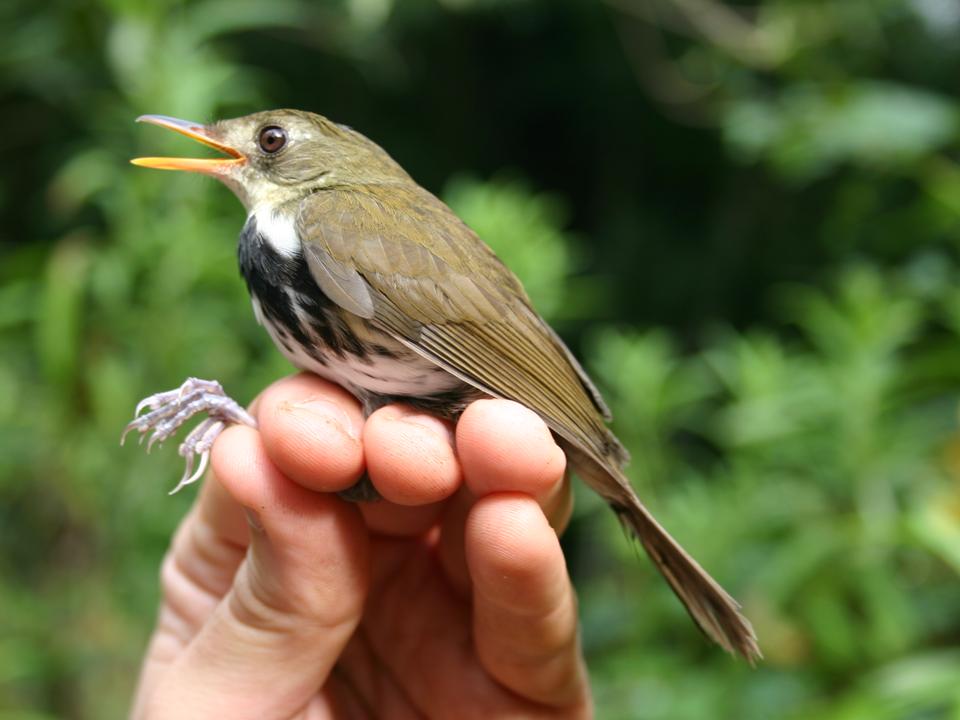
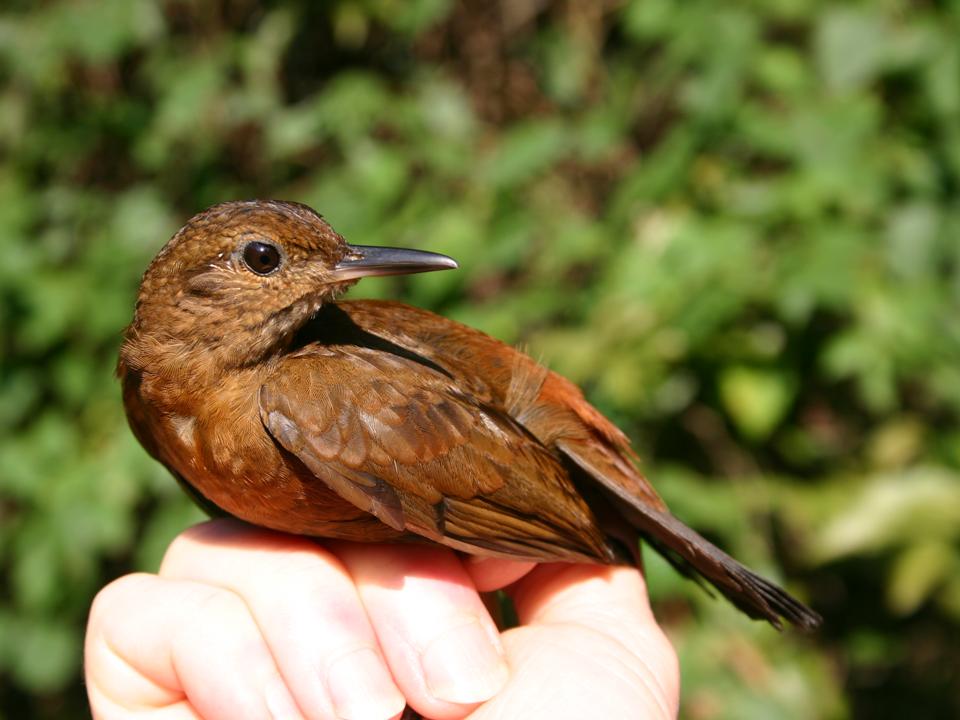

FAUNA Paraguay Technical Publication Number 1
October 2005
INTRODUCTION
The Atlantic forest of southern Brazil, eastern Paraguay and northeast Argentina has been declared by Conservation International to be in need of “Critical Conservation Attention”, highlighting the rapid rate of deforestation of this unique habitat (Galindo-Leal 2003). In keeping with developments elsewhere the Atlantic forest of Paraguay is being cleared at an alarming rate. Best estimates suggest that as little as 8% of the original cover may remain, much of that unprotected and/or in a modified or highly-fragmented state. In the southern department of Itapúa the situation is particularly bad, with extensive clearance for agriculture (principally soya and cotton) and that forest which does remain generally does so because of the unsuitability for farming of the land on which it stands. One exception to this general rule is the small patch of forest at Hotel El Tirol, located near the town of Capitán Miranda in the extreme south of the department. Though it receives no official protection, its continued existence has much to do with its aesthetically pleasing nature for hotel guests, and with numerous Atlantic forest endemic species present and ease of access it would seem to be perfectly suited for ecotouristic development. During June 5 to July 1 2005 we performed an avifaunal inventory of the site as part of the preparation of a bilingual “mini field guide” series to the best birdwatching sites in Paraguay being produced in association with the BirdLife International Partner Guyra Paraguay. A week long follow-up project was performed during the early breeding season from October 1 to October 7 2005 when migrant birds were present.
AIMS
El Tirol has been the subject of a series of papers by the US ornithologist Mercedes Foster, most written while performing collecting expeditions for the Smithsonian Museum in Washington during the late 1970s and early 1980s. Though deforestation had already begun at that time, the surrounding forest was considerably more extensive than it is today. The species recorded and collected during these expeditions are hereafter referred to as the “old list”. Save for a brief collecting visit by Foster and Carlo Cicero (Berkeley) during June 2004 further ornithological work at the site has been limited to brief, intermittent and unsystematic visits by passing ornithologists, notably Floyd Hayes in the late 1980s and again in 1994 and 1997. One notable result of the June 2004 collecting expedition was the addition to the list of several “open-country” species such as Bananaquit Coereba flaveola and Fork-tailed Woodnymph Thalurania furcata both of which have undergone population explosions in Paraguay having been known from very few records prior to 2000 (Hayes 1995, Clay 2004). With numerous more strictly forest species remaining unrecorded since the collection of the 1980s specimens we aimed to perform a thorough avian inventory of the site to produce a complete “modern list” for comparison with the “old list” in order to measure the effects of fragmentation on the El Tirol avifauna. In the process a basic bilingual field guide to the birds of the site would be produced to hopefully stimulate interest in birds and conservation amongst hotel guests and contribute to the continued protection of the forest.
STUDY SITE
Hotel Tirol consists of approximately 40ha of Lowland Paraná Atlantic Forest. The forest is not uniform and may be split into clearly defined sections depending on the level of disturbance. The forest around the hotel buildings is the most disturbed, being less than 40 years of age with an open undergrowth and is probably best defined as “capuera” or secondary-growth. A small, turbulent stream runs through the centre of the “older” section of forest, and short trails leading to stumps of “red wood” tree species suggests that selective-logging has or does take place. The land is gently undulating and quite rocky here, its unsuitability for farming perhaps contributing to its continued existence. In the flattest area a small section of forest has been cleared at some stage in the past to make way for a small orchard and eucalyptus plantation, though both appear to have fallen into disuse. At the furthest end of the property is the thickest and most undisturbed forest with mature trees and dense undergrowth. Adjacent to the property is a second property of approximately the same dimensions. The forest here is continuous with that of the hotel but is considerably more disturbed with considerable evidence of recent tree clearance and logging. The rest of the property has been cleared and is grazed by cattle, the majority being covered by an open grassy or thorny, semi-xerophytic scrub-type vegetation. The owners of Hotel Tirol have expressed an interest in purchasing this adjacent property with a view towards replanting the land with native tree species. From hereon this section of the study site is referred to as “the scrub”.
Species Added To Modern List
Barred Forest-falcon Micrastur ruficollis - Heard calling in the early morning and evening on 3 occasions (PS, DO, HDC) during the June project and once during the October project. This secretive species is easily overlooked when not vocalizing.
American Kestrel Falco sparverius - Recorded on two occasions, the first involving a pair of birds in the scrub (June 10 PS, HB, RN). The second record was of a single bird flying over the forest on June 12 (HB, DO, RN, BW). The addition of this species to the modern list was of no surprise as the species is common in the surrounding area.
Rufous-thighed Kite Harpagus diodon - One or two birds seen on three separate days during the October project with the first record of a flying bird clearly showing rufous underwing coverts on October 3 (PS, SW). This migrant species is unlikely to have been present during the June project.
Robust Woodpecker Campephilus robustus - The distinctive double-drum of this large woodpecker was heard most days during the June project. The only sight records were of a pair of birds on June 20 (RN) in the densest area of the forest and a single bird on July *** (HB). The continued presence of this species at Tirol is encouraging as, being a large woodpecker requiring a large territory, it may be considered an indicator of a healthy forest. It was not recorded during the October project.
Plain Xenops Xenops minutus - Numerous observations and two individuals trapped during the June project suggest that this tiny xenops is not uncommon in the forest.
Tufted Antshrike Mackenziana severa - A male observed on June 8 (PS, BW, RN, DO) represented the first modern record of this species. At least 5 vocalising birds were recorded almost daily in various sections of the forest during both projects.
Rufous-winged Antwren Herpsilochmus rufomarginatus - Common in the forest canopy. The similarity of this species call to that of the abundant Plain Antvireo Dysithamnus mentalis may explain why the species went unrecorded for so long. Not recorded during the October project.
White-shouldered Fire-eye Pyriglena leucoptera - Secretive but apparently fairly common. Four birds were netted, several were seen and vocalizations were heard most days during the June project, with a single voice record from the October project.
Short-tailed Antthrush Chamaeza campanisoma - At least 3 birds vocalizing daily during both projects confirmed the continued existence of this secretive species at the site. Ground-dwelling insectivorous birds are often among the first species to disappear and its continued existence at the hotel is encouraging.
White-crested Elaenia Elaenia albiceps - A single bird netted on October 1 is the first modern record of this migrant species. It was common in the canopy during the October project.
Tawny-crowned Pygmy-tyrant Euscarthmus meloryphus - Vocalising birds in the scrub on June 23 (HDC). This tiny flycatcher is fairly common in southern Paraguay.
Pearly-vented Tody-tyrant Hemitriccus margaritaceiventer - Single bird in the scrub on June 23 (HDC).
Eastern Sirystes Sirystes sibilator - A single bird observed in the canopy on June 21 by all observers. Vocalising birds were heard on numerous other occasions during the June project.
Piratic Flycatcher Legatus leucophaius - A single vocalizing bird in the canopy near the hotel buildings on October 7 is the first modern record of the species. Direct comparison with the similar Variegated Flycatcher Empidonomus varius was possible and the bird was smaller, shorter-tailed and somewhat yellower below. The bird is likely overlooked in the forest canopy and easily detected only when calling.
Violaceous Euphonia Euphonia violacea - Faiirly common member of mixed frugivorous/insectivorous flocks. Both males and females were observed on an almost daily basis during the June project but were unrecorded during the October project when most flocks had disbanded. Confusion with the common Purple-throated Euphonia Euphonia chlorotica may explain the lack of modern records.
Diademed Tanager Stephanophorus diadematus - A single bird observed in a mixed flock by two observers unfamiliar with the species. This bird was clearly larger than other tanagers in the flock and though light was poor the steel-blue colouration was clearly apparent. However, viewing from below the observers were unable to see the diagnostic coronal patch. If correctly identified it represents the first record for Paraguay since the inception of Guyra Paraguay in 1997.
AN AVIFAUNAL INVENTORY OF HOTEL TIROL,
DEPARTAMENTO ITAPÚA, SOUTHERN PARAGUAY
Paul Smith, Hugo del Castillo, Hemme Batjes, Adam Betuel, Monica Montiel, Regis Nossent,
Derek Onley, Bryan Wainwright and Sally Wechsler
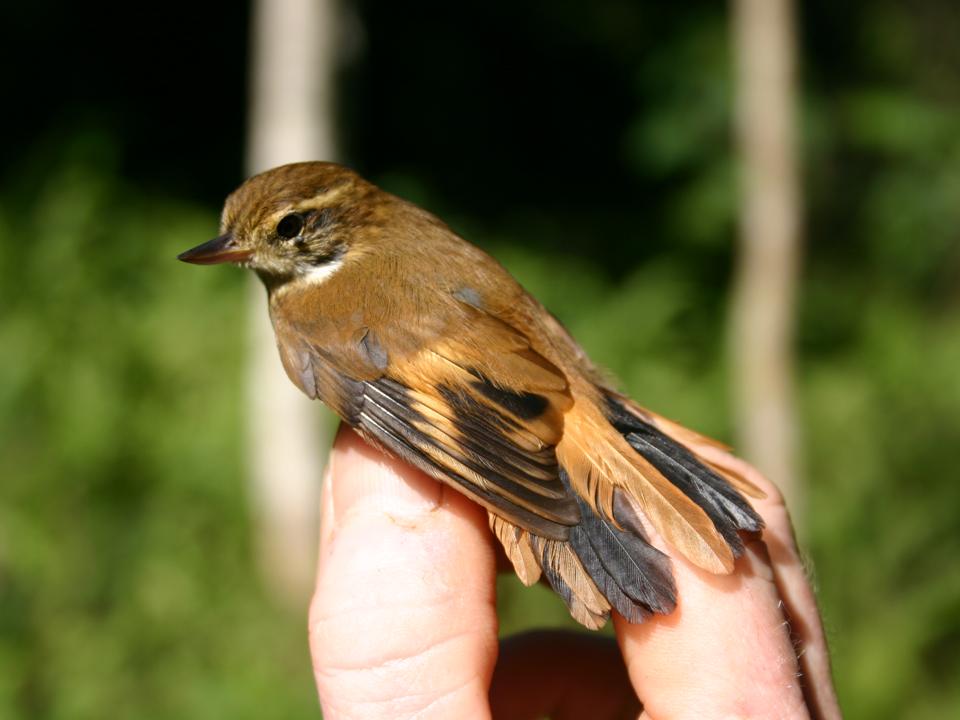
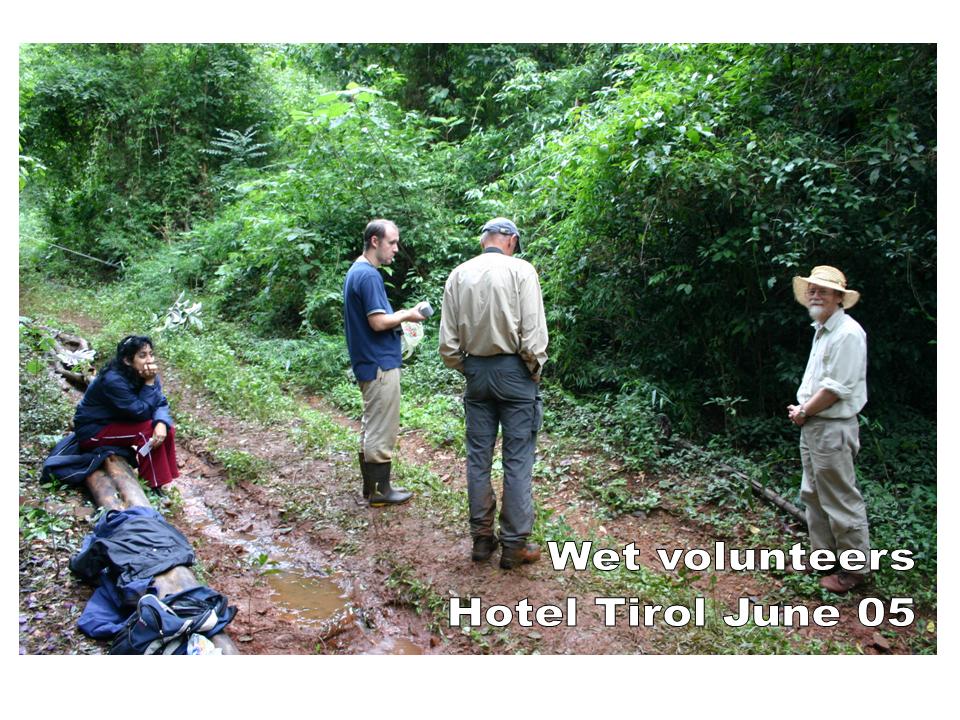
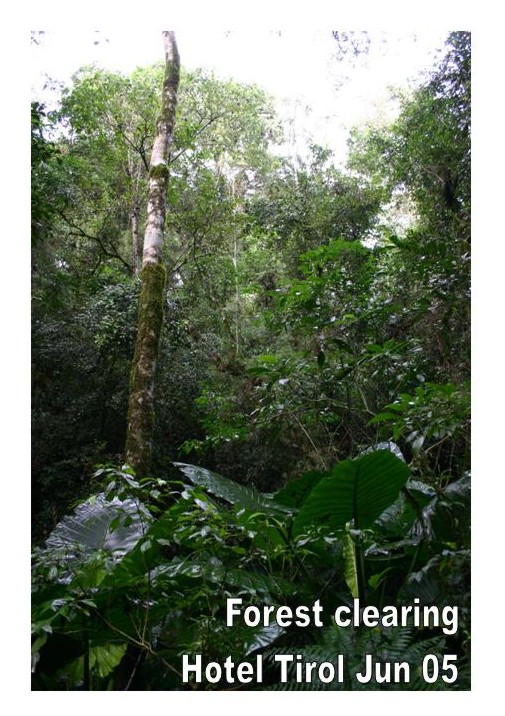
METHODS
Fieldwork was conducted during 27 days in June 2005. Though the weather was generally fine and sunny, approximately 6 consecutive days of work were lost in the middle of the project due to unseasonally heavy rains. We operated 8 mist nets of c85m total length at varying sites throughout the forested area of the property, their locations being rotated at approximately weekly intervals. No netting was performed in the scrub area, this being considered of limited conservation priority. Two high nets of c9m, in height were erected for netting birds in the subcanopy. Netting was performed for c9hrs each day, with nets closed during periods of rain and at night. Taped recordings were used sparingly to assist in the trapping of certain species. All birds were measured and weighed on removal (see Appendix D for measurements), their age and condition assessed, selectively photographed and released. A short follow-up project was performed for 7 days from October 1 until October 7 2006, the Paraguayan Spring. Though there were some periods of light rains no full days were lost. October fieldwork concentrated entirely on the forest with no work in the scrub. During the October follow-up project just 4 nets of c36m were operated, with no nets in the canopy.
The surrounding forest and scrub were surveyed by observers walking pre-existing trails. The level of experience of the observers with Paraguayan birds varied from novice to very experienced, but all had a good grounding in Neotropical birding elsewhere. Visibility censuses were performed by BP and HB (see Appendix B for methods and results).
For the purposes of simplicity an arbitrary date of 1997 (the inception of Guyra Paraguay and the beginning of the collection of records for their database) has been chosen as the start-point of records for the “modern list”.
RESULTS
A total of 170 species were recorded during the course of the field work (149 during June and 103 during October), with 44 species netted (41 during June and 14 during October). Of the species recorded 11 were completely new for Tirol, though 8 of these may be considered open-country birds. A further 16 species from the old list were added to the modern list, only 3 of these being open-country species. A further 5 species from the old list were recorded in the area immediately around the study area (ie within 2km of its boundaries) and may reasonably be expected to occur within the hotel area, though for now they remain on the old list pending confirmation from within the study area. After the completion of field work the list totals stand at 236 for the old list and 189 for the modern list. Of the 44 species not yet recorded on the modern list 3 species (White-bellied Tyrannulet, White Monjita and Rufous-fronted Thornbird) are considered questionable at Tirol and may have been collected elsewhere; 3 (Bare-faced Ibis, Cocoi Heron and Black-crowned Night-heron) are fly-over species of irregular occurrence but likely to be recorded at any time and 9 (Spot-winged Wood-quail, Scaled Dove, Ferruginous Pygmy-owl, Little Nightjar, Scissor-tailed Nightjar, Toco Toucan, Black-throated Trogon, Spot-backed Antshrike and Eastern Slaty-thrush) are fairly conspicuous resident species that we would have expected to have recorded during the period of fieldwork had they been present. Details of the sightings of the new species recorded are given below:
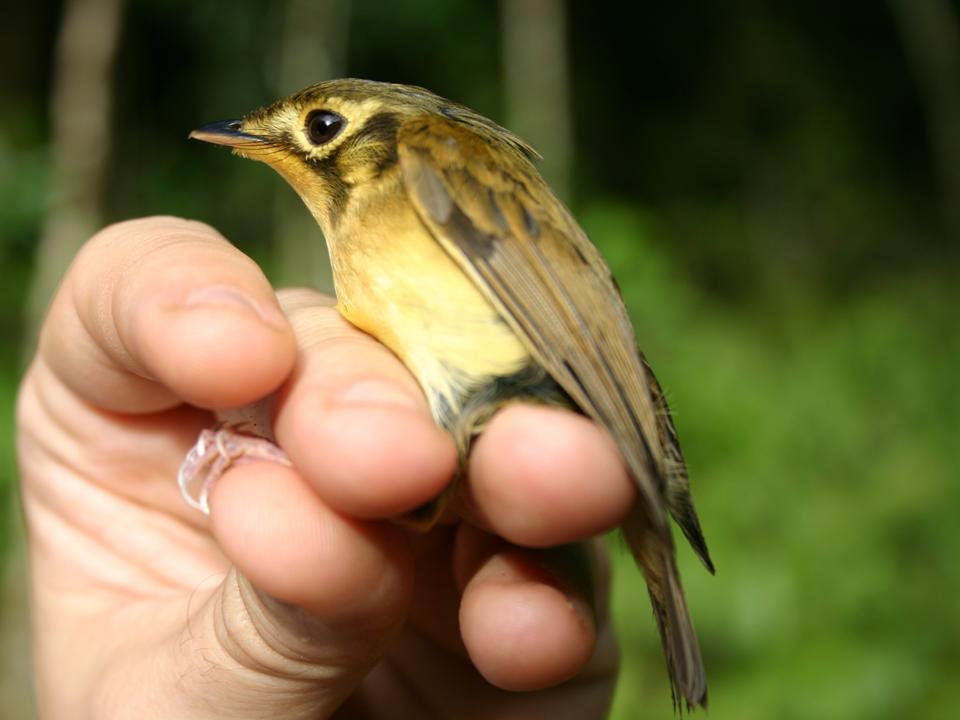
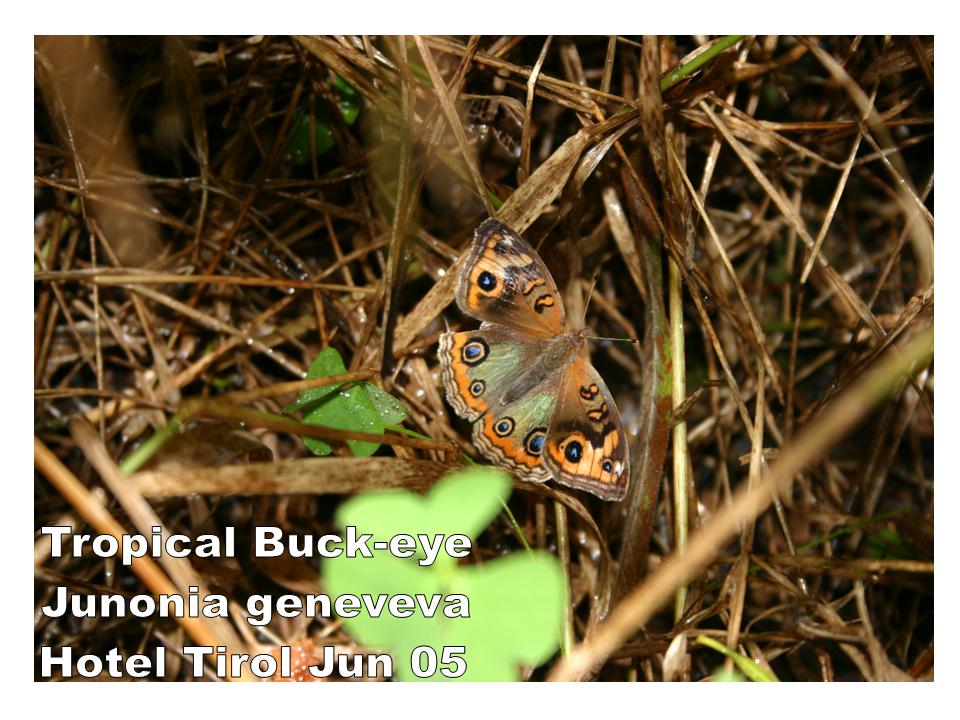
New Species
Spotted Nothura Nothura maculosa - Heard calling (HDC) on several occasions in the scrub and in surrounding areas outside the hotel during the June project. This is the commonest open-country tinamou in Paraguay and though locally affected by hunting appears to be well able to adapt to the agricultural and ranch habitats that have replaced the traditional forest.
Grey-headed Kite Leptodon cayanensis - A single adult light phase bird observed on two separate days during the June project (DO, HB, BW, RN) soaring low over the forest. This species is easily identified by its pale underparts and contrasting black wing linings and barred tail and flight feathers. The species was observed again during the October project.
White-tailed Hawk Buteo albicaudatus - Single adult birds were seen on several occasions by all observers during both projects. It was identified by the typical Buteo shape and white tail with dark sub-terminal band. This species is not uncommon in open areas in Paraguay and though usually seen soaring was flushed on several occasions from a perch in tall eucalyptus at the edge of the scrub.
Laughing Falcon Herpetotheres cachinnans - Two records of a single bird, and then of a pair flying low over the forest seen by all observers during the June project. Despite the sight records the birds were never heard to vocalize.
Ruddy Quail-dove Geotrygon montana - A female netted on October 1 is the first confirmed record of this secretive species at Tirol. A description of a dove matching this species was given by DO during the June project but failed to rule out other confusion species.
Blue-tufted Starthroat Heliomaster furcifer A single female observed feeding at flowers at the edge of the orchard on October 4 (PS, SW). The bird showed a clear white spot behind the eye, an exceptionally long black bill and a greenish tail. This is a common bird in open habitats in Paraguay and its occurrence at Tirol is not a surprise.
Narrow-billed Woodcreeper Lepidocolaptes angustifrons - Single birds were seen on numerous occasions in scrub during the June project (BW, PS, HB, RN, HDC, MM). This bird could be easily split from Lesser Woodcreeper (its forest equivalent) by its larger size, longer pinkish bill and much whiter eyebrow and underparts.
Chotoy Spinetail Schoeniophylax phryganophila - A single bird observed in scrub on June 27 (RN, HB, PS). This is a common bird of scrubby areas in southern Paraguay and may be expected to be recorded with increasing regularity.
White-crested Tyrannulet Serpophaga subcristata - A single bird observed in scrub on June 10 (RN, HB, PS). This is a common bird of scrubby areas in southern Paraguay and may be expected to be recorded with increasing regularity.
Lowland Hepatic-tanager Piranga flava - A pair observed on June 12 in the scrub was the first and only record of this distinctive tanager (HB, RN).
Green-winged Saltator Saltator similis - Observed feeding in fruiting trees around the hotel buildings with some regularity during the June project, this species appears to be not uncommon. A specimen collected during June 2004 and initially identified as this species is actually a juvenile Greyish Saltator Saltator coerulescens (specimen examined) thereby making the June 15 2005 observation the first official record of the species at the site.
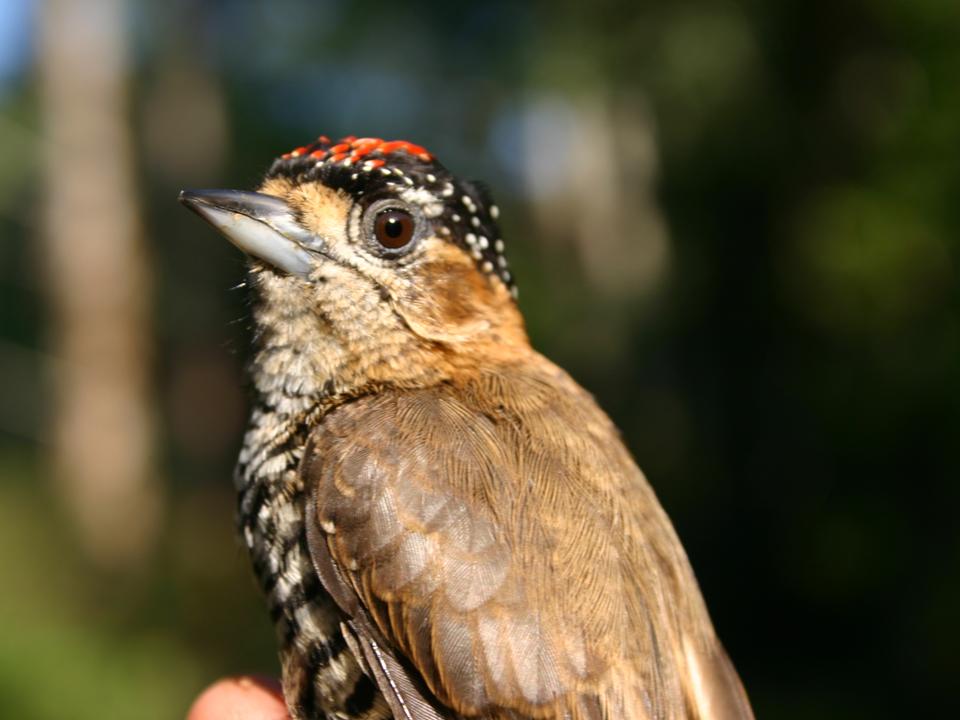
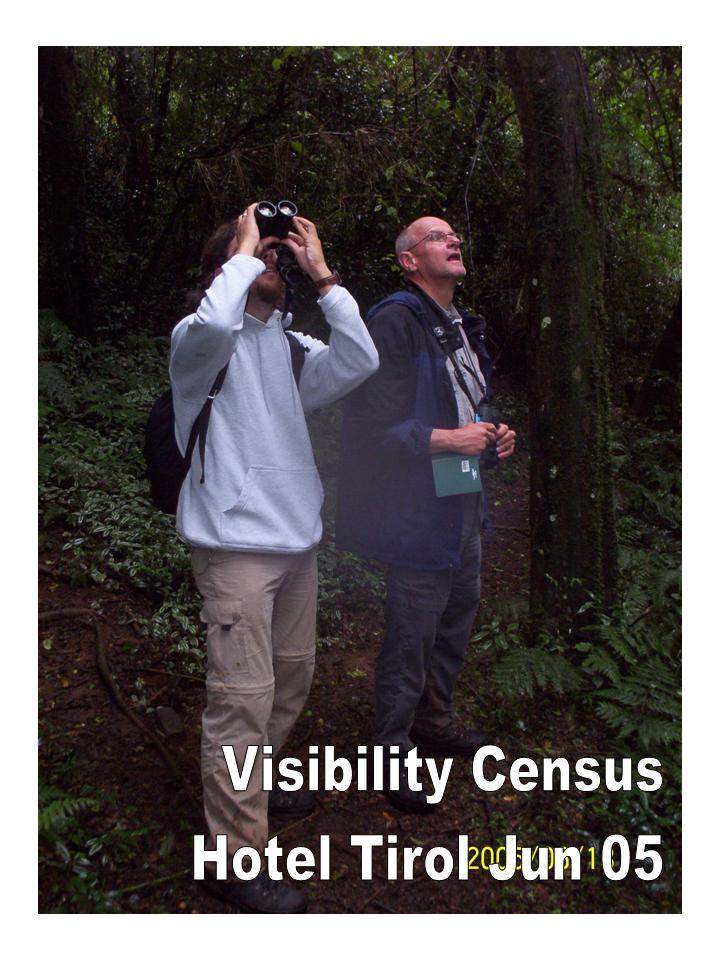
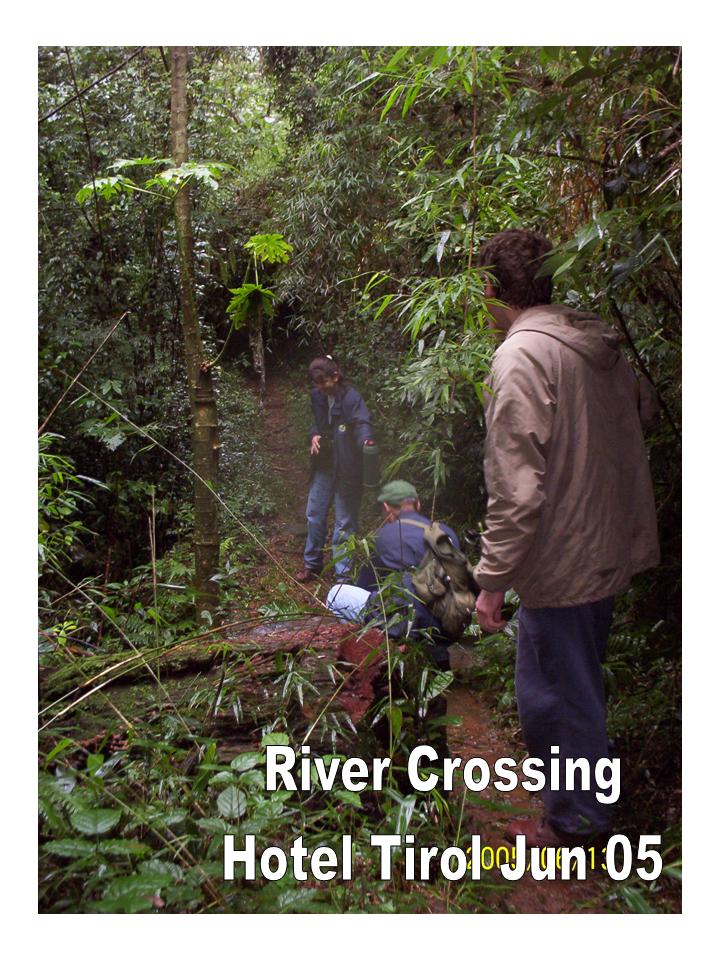
Species From Old List Recorded Within 2km of the Study Area but not Within it.
Chicli Spinetail Synallaxis spixi - A single bird observed in bushy scrub just outside the boundary of the study area during the June project. The complete bright rufous cap, rufous shoulders and brown wings and tail were sufficient for identification. Vocalising birds were recorded at the same locality during October project.
Large-tailed Antshrike Mackenziana leachii - A vocalising male was recorded in bushy scrub just outside the boundary of the hotel and found to be present on every occasion that the site was visited during June and October. Numerous other vocalizing birds in the surrounding areas suggest that the paucity of records of the species in southern Paraguay may be more related to unfamiliarity with the call than the rarity of the bird.
Masked Yellowthroat Geothlypis aequinoctialis - Recorded just outside the hotel boundary at a small pond. Suitable habitat for this species does not occur within the study site, raising the question as to whether previous records quoted from Tirol are actually from areas adjacent to the hotel. This species is an abundant inhabitant of wetland sites in southern Paraguay.
Blue-black Grassquit Volatinia jacarina - Numerous in tall grass areas just outside the study area. Likely to occur in the scrub though not recorded during fieldwork.
Chopi Blackbird Gnorimspar chopi - Found to be numerous, vocal and conspicuous in open habitats just outside the study area. Likely occurs regularly in the scrub though not recorded there during fieldwork.
Possible Species
Tawny-browed Owl Pulsatrix koeniswaldiana - A large brown owl seen by an inexperienced observer (DO) on the first day of the June project seemed to match the descriptions of large owls seen on several occasions at close range by the hotel owners. Armando Reynaers indicated that the owl was a Pulsatrix and distribution suggests that koeniswaldiana is the most likely species.The species would be new for Tirol.
Southern Scaled Woodcreeper Lepidocolaptes falcinellus - A medium-sized woodcreeper with a supercilium observed briefly in the forest during the June project (PS, DO) was probably this species. It appeared to be larger than Lesser Woodcreeper Lepidocolaptes fuscus but otheriwse similar and no other plumage characteristics could be noted. This species would be new for the modern list but requires confirmation.
Grey-rumped Swift Chaetura cinereiventris - A flock of six swifts observed during the June project over the scrub may have been this species (HB, BW), resident in Paraguay. Sick´s Swift Chaetura meridionalis is an extremely visible migrant bird during the summer months but is absent during the winter when these birds were observed. However no details that eliminated the possibility of an over-wintering group of Sick´s Swift were given in the description and the continued presence of the species at Tirol requires confirmation. The species would be new for the modern list. THIS SPECIES WAS CONFIRMED ON 26 AUGUST 2006
ATLANTIC FOREST ENDEMICS AND THREATENED SPECIES
Fifty-four per cent (42 of 78) of the Atlantic forest endemic species found in Paraguay have been recorded at Tirol, a large number for a comparatively small and isolated tract. Of these 42 we recorded 30 (71.5%) during our field work. No globally threatened and just 3 globally near threatened species are on the modern list at Tirol (Bird Life International 2004). Two of these three species were recorded during the field work, with the bamboo specialist Blackish-blue Seedeater Amaurospiza moesta being unrecorded.
The abundance of Amaurospiza at the site may be related to the flowering of bamboo. Southern Bristle-tyrant Phylloscartes eximius is common throughout the forest and was recorded daily, while Creamy-bellied Gnatcatcher Polioptila lactea was recorded only once. The lack of globally threatened species should not diminish the importance of Tirol for conservation. It is one of the last remaining “protected” forest areas in southern Paraguay. 63 species recorded here are of national conservation concern (see Appendix C), representing twenty-seven per cent of the total species list for the site.
SPECIES COMPOSITION
The most striking feature of the midwinter bird communities at Tirol are the mixed species flocks. Typically these occurred in the canopy (understorey mixed species flocks being encountered only on rare occasions) and revolved around a core of species that appeared to accompany every flock - notably Tropical Parula, Blue Dacnis, Guira and Sayaca Tanager, Purple-throated and Violaceous Euphonia and Chestnut-vented Conebill. Other species such as Chestnut-bellied Euphonia, Blue-naped Chlorophonia, Rufous-crowned Greenlet and Yellow-olive Flycatcher were often, but not always present. The dominant species by number in these flocks was invariably Guira Tanager, followed by Blue Dacnis. Approximately midway through the project (cJune 23) the number of Dacnis encountered in these flocks seemed to tail off for reasons unknown and the species became considerably less easy to find. During the October project the mixed species flocks were much less visible, but were occasionally encountered during colder weather. These flocks were smaller but still based around the Guira Tanagers, which were joined by migrant Red-eyed Vireo as the second most abundant species. No Euphonias or Dacnis were observed with these flocks during the October project. Understorey mixed species flocks were encountered on very few occasions, generally accompanying a canopy flock above them. Typical species of such flocks included Red-crowned Ant-tanager, Ruby-crowned Tanager, Lesser Woodcreeper and Greenish Schiffornis.
Prior to the project very few species of raptor or antbird had been recorded on the modern list for Tirol. The under-recording of raptors was probably due to under-watching of the site and four species were added to the modern list during the course of the fieldwork. The under-recording of antbirds was likely related to their secretive nature. However most species are very vocal and five species were added to the modern list after first being detected by call.
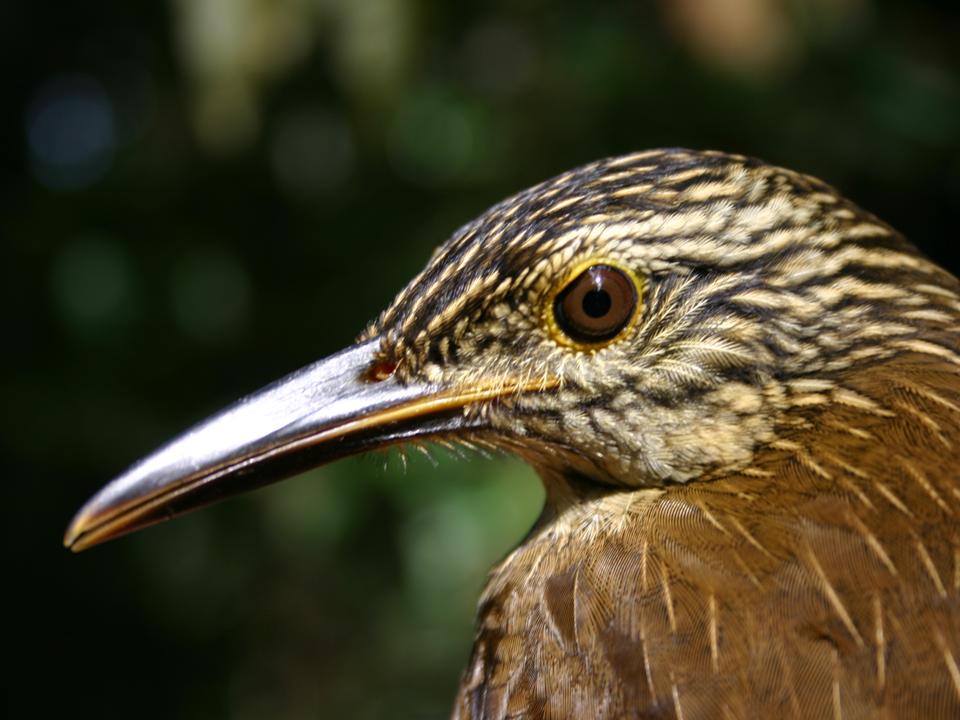
The visibility censuses (Appendix A) confirmed the initial impressions that Golden-crowned Warbler and Black-goggled Tanager are amongst the most numerous of forest inhabitants. These were also the most frequently netted species. Guira Tanager and Pale-breasted Thrush score high on the visibility index because of their conspicuousness, the former as the core member of mixed species flocks and the latter because of its bold, noisy behaviour, though neither were netted with regularity. However, several other species found to be numerous based on net captures and voice recording did not score well on the visibility censuses. Species such as Variable Antshrike, Plain Antvireo, White-eyed Foliage-gleaner, White-rimmed Warbler and Blue Manakin are all clearly common birds but reclusive in behaviour. White-rimmed Warbler for example was not seen during the October project despite being heard to vocalise frequently every day. Tufted Antshrike and Short-tailed Antthrush both vocalised almost constantly throughout the course of both projects yet had previously not been recorded on the modern list because of their secretive nature.
The main difference between the species recorded during the June project and the October project was the arrival of the migrants for the latter. Easily the most numerous of these were Sick´s Swift and Red-eyed Vireo, which calls constantly throughout the day. Other seemingly common and conspicuous migrant species include Variegated Flycatcher, White-crested Elaenia and Euler´s Flycatcher. A total of 13 migrant species were recorded during the October project and with more time more might be expected. The arrival of Chestnut-banded Nighthawk seemed to coincide approximately with the beginning of the October project. This species was considered a questionable breeding resident (Clay and del Castillo 2004) but its disappearance from Paraguay during the winter months seems to confirm that it is actually a breeding northern migrant at least in the south of the country.
It is noticeable that certain species are associated with “micro-habitats” within the forest. Yellow Tyrannulet and Eared Pygmy-tyrant for example seem to be almost exclusively associated with Chusqueia bamboo tangles at forest edge, while Brown Tinamou, Band-tailed Manakin and Robust Woodpecker are confined to the oldest, densest and least disturbed sections of the forest. Pale-breasted and Rufous-bellied Thrushes on the other hand are most numerous in the disturbed secondary growth forest around the hotel buildings where the undergrowth is more open.
The following species were recorded only by voice and not seen by any observer during the course of the field work - Brown Tinamou, Barred Forest-falcon and Grey Potoo.
FURTHER OBSERVATIONS OF INTEREST
During the September/October project evidence of breeding was found in Golden-crowned Warbler (ground nest with 3 recently hatched young located on October 2), Swallow-tanager (nest-building), Sayaca Tanager (nest-building), Purple-throated Euphonia (nest-building) and Yellow-olive Flycatcher (active nest).A pair of Sayaca Tanager were seen to mate in a tall, bare canopy tree, the two birds facing each other and appearing to “kiss” in a kind of stylised display shortly after copulation!!
Displaying male Plovercrests were located in a clearing filled with Chusqeuia bamboo - the same area where the birds were seen displaying the previous year. Males adopted a prominent perch in the sunlight and sang while turning the head from side to side so that the sunlight reflected from the iridescent purple crest. One bird on October 4 was seen to perform a short side to side flight before returning to his perch and continuing to sing. The previous year as many as four males had been seen displaying around this clearing, but during the project a maximum of two were observed.
A single Chestnut-banded Nighthawk was located at a roost that had been occupied the previous year, suggesting a degree of roost-site fidelity in this species. This conspicuous species (at least when in flight) was first observed on October 5, probably the arrival date from migration. The hotel guard who is familiar with the species and the roost did not see the birds prior to this date and they were recorded every day afterwards. HDC reported the species from Mbaracayú Reserve, Departamento Canindeyú some two weeks prior to this, though the reserve is located considerably further north in the country.
A pair of Slaty-breasted Wood-rails were watched going to roost in a tree approximately 3m from the ground on June 14. The tree was located adjacent to a wide path along which the birds had been regularly observed during the early morning and late afternoon. The roost was not occupied the following night.
During rain the number of swifts circling in the skies above the hotel increased dramatically from c15 to c60 individuals. The reasons for this are unclear but are likely related to better foraging conditions over the forest, or perhaps a worsening of foraging conditions elsewhere forcing the swifts to congregate in optimal areas.
The following mammals were recorded during fieldwork - Tayra Eira barbara, Crab-eating Fox Cercodyon thous, Crab-eating Raccoon Procyon cancrivorus (footprints), Hairy Tree Porcupine Sphiggurus spinosus, Brown Capuchin Cebus apella and Fruit-eating Bat Artibeus jamaicensis/planirostris? (roost). Prior to the projects Lesser Grison Galictis cuja had also been seen at the site (PS). The hotel owners report that Tamandua Tamandua tetradactyla (perhaps unlikely to still occur), White-eared Opossum Didelphis albiventris (specimen found dead on the road near to hotel entrance by PS) and Brazilian Rabbit Sylvilagus brasiianus are also present. It seems likely that Cavy Cavia aperea, numerous species of rodent, several bats and probably armadillos also occur.
DISCUSSION
Despite considerable fragmentation and massive reduction in the Atlantic forest in the Itapúa region of Paraguay the species composition at Tirol remains essentially as it was 20 years ago. Species from the old list are slowly being added to the modern list and new species are continually being recorded. However this is not as positive as it may seem - firstly it is well known that the effects of forest fragmentation are delayed (Brooks 1999) ie local extinctions may not take place for several decades after the habitat is no longer optimal; secondly no abundance data exists with the old list so we are unable to compare which species have declined and which have increased in the intervening period. What is notable is that of the 11 species added to the site list during our period of fieldwork, 7 (63.5%) were open country species, while only 4 of the 16 species (25%) added to the modern list from the old list could be considered to be non-forest species. This suggests a considerable invasion of open-country species into the area in the last 20 years, which might be the first expected result of fragmentation. Though fairly well protected the bird populations at Tirol are likely fragile and with continued fragmentation in the surrounding area will become increasingly susceptible to local extinctions. Lack of immigration by forest species from surrounding areas will reduce the genetic health of the local bird populations, while the effects of the limited hunting on larger species by local human populations will be magnified as isolation increases. That said some forest is visible on the horizon to the north heading towards San Rafael National Park and if a green corridor can be established and maintained in the immediate future then the effects of fragmentation may be reversible (Madroño 1997).
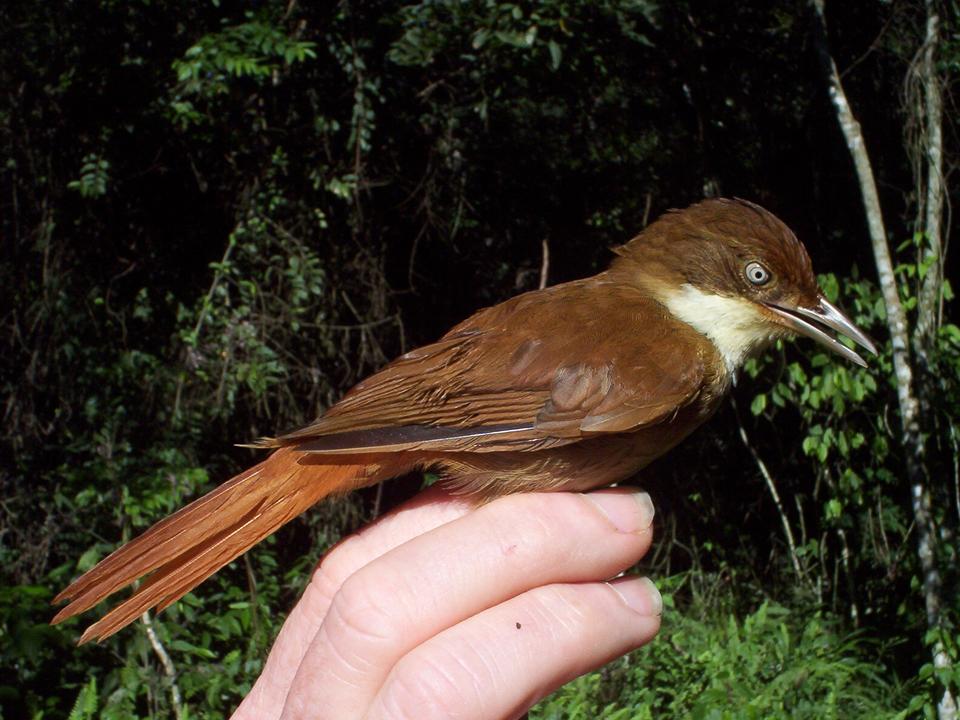
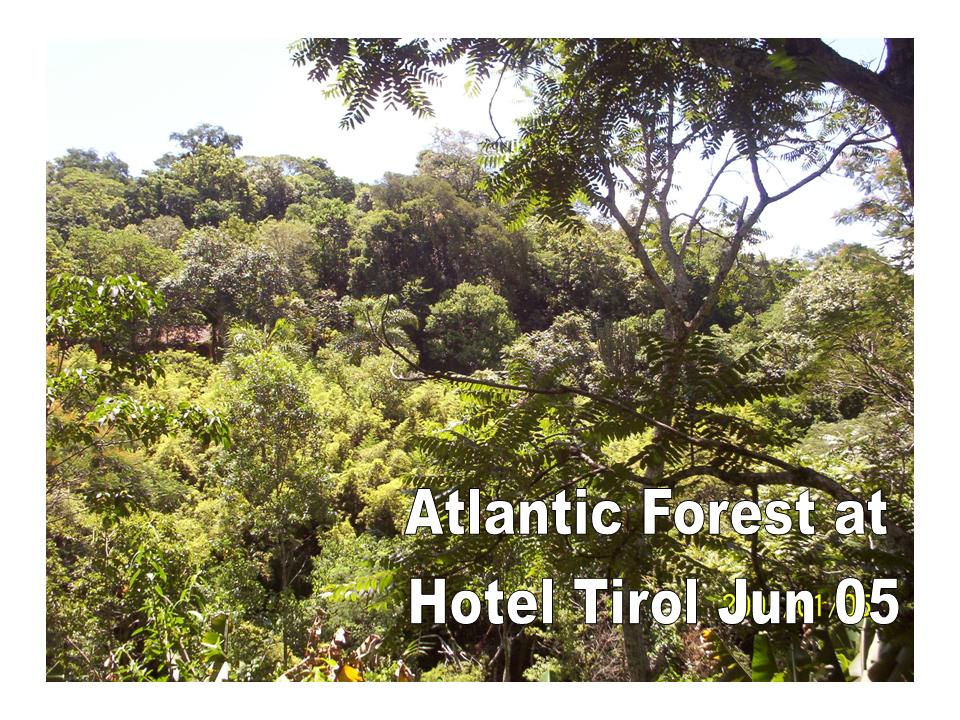
CONCLUDING REMARKS
With ecotourism still in its infancy in Paraguay travel for independent birders can be difficult. This has led to Paraguay becoming something of a “forgotten corner” of South America, despite having a species list that compares more than favourably with similar-sized areas of neighbouring countries. With international attention diverted elsewhere, the plight of the Paraguayan Atlantic forest and its other endangered habitat types has gone somewhat unnoticed by both the local population and the international birding community. In terms of the Atlantic forest, conservation efforts have been aimed at convincing landowners that they can make a sustainable income by preserving their forest rather than the current “boom and bust” attitude of clearing it for a rapid, but finite income.
One aspect of sustainable development that has yet to be fully explored is the development of ecotourism. Hotel El Tirol with its comfortable and modern installations and easy access would seem ideally suited to capitalize on any increase in eco-travel to Paraguay. For novice birders it is an ideal location to become acquainted with the Atlantic forest birds, while more serious birders will find the large number of endemics coupled with the comfort and ease of the birding amenable. Through the production of the El Tirol mini guide, and subsequent titles in the “Mini-Guides to the Birds of Paraguay” series we hope to raise interest and awareness amongst locals, landowners, birders and biologists in the rich but imminently threatened “naturaleza” of Paraguay and to assist in some small way the conservation of important, but hitherto unprotected sites with eco-touristic potential.
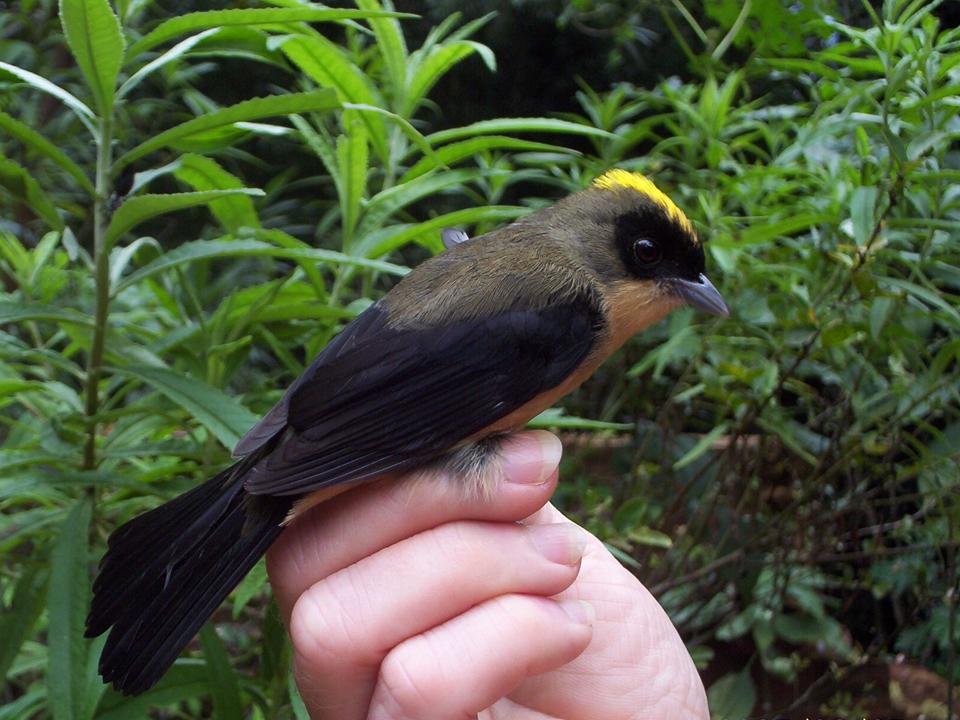
1.Golden-crowned Warbler 538 (30) 11.45 9.64
2.Black-goggled Tanager 443 (28) 9.43 7.40
3.Guira Tanager 384 (22) 8.17 5.51
4.Pale-breasted Thrush 277 (22) 5.89 3.23
5.Ruby-crowned Tanager 263 (16) 5.60 2.30
6.Blue Dacnis 233 (15) 4.96 2.09
7.Sayaca Tanager 176 (10) 3.74 -0.19
8.Black Vulture 173 (10) 3.68 -0.26
9.Tropical Parula 165 (12) 3.51 -0.21
10.Variable Antshrike 140 (13) 2.98 -0.43
11.Rufous-bellied Thrush 133 (9) 2.83 -1.21
12.Chestnut-vented Conebill 116 (9) 2.47 -1.57
13.Sepia-capped Flycatcher 104 (8) 2.21 -1.94
14.Fork-tailed Woodnymph 93 (6) 1.98 -2.38
15.Yellow Tyrannulet 90 (8) 1.91 -2.23
16.White-tipped Dove 87 (7) 1.85 -2.40
17.White-eyed Foliage-gleaner 78 (6) 1.66 -2.70
18.Roadside Hawk 77 (7) 1.64 -2.62
19.Red-crowned Ant-tanager 76 (4) 1.62 -2.96
20.Purple-throated Euphonia 67 (6) 1.43 -2.94
21.Monk Parakeet 66 (4) 1.40 -3.17
22.Ochre-breasted Foliage-gleaner 60 (6) 1.28 -3.09
23.House Wren 57 (5) 1.21 -3.26
24.Southern Bristle-tyrant 57 (5) 1.21 3.26
25.Plain Antvireo 51 (4) 1.08 -3.49
26.Picazuro Pigeon 50 (5) 1.06 -3.40
27.Yellow-olive Flycatcher 47 (4) 1.00 -3.57
28.Plush-crested Jay 44 (2) 0.94 -3.85
29.Scale-throated Hermit 40 (4) 0.85 -3.72
30.Blue-naped Chlorophonia 37 (3) 0.79 -3.89
31.Squirrel Cuckoo 37 (3) 0.79 -3.89
32.White-necked Thrush 37 (3) 0.79 -3.89
33.Violaceous Euphonia 34 (2) 0.72 -4.06
34.Bananaquit 30 (3) 0.64 -4.04
35.Eared Pygmy-tyrant 30 (3) 0.64 -4.04
36.Fawn-breasted Tanager 30 (3) 0.64 -4.04
37.Great Kiskadee 30 (3) 0.64 -4.04
38.Ochre-collared Piculet 30 (3) 0.64 -4.04
39.Olivaceous Woodcreeper 30 (3) 0.64 -4.04
40.Rufous-capped Motmot 30 (3) 0.64 -4.04
41.White-rimmed Warbler 30 (3) 0.64 -4.04
42.Rufous-crowned Greenlet 30 (2) 0.64 -4.14
43.Southern Lapwing 23 (1) 0.49 -4.40
44.Red-crested Finch 20 (2) 0.43 -4.57
45.Ruddy Ground-dove 17 (1) 0.36 -4.53
46.Slaty-breasted Wood-rail 17 (1) 0.36 -4.53
47.Boat-billed Flycatcher 10 (1) 0.21 -4.68
48.Cattle Egret 10 (1) 0.21 -4.68
49.Chestnut-bellied Euphonia 10 (1) 0.21 -4.68
50.Chestnut-eared Aracari 10 (1) 0.21 -4.68
51.Chestnut-headed Tanager 10 (1) 0.21 -4.68
52.Epaulet Oriole 10 (1) 0.21 -4.68
53.Green-winged Saltator 10 (1) 0.21 -4.68
54.Grey-bellied Spinetail 10 (1) 0.21 -4.68
55.Grey-headed Kite 10 (1) 0.21 -4.68
56.Greyish Saltator 10 (1) 0.21 -4.68
57.Guira Cuckoo 10 (1) 0.21 -4.68
58.Laughing Falcon 10 (1) 0.21 -4.68
59.Mottle-cheeked Tyrannulet 10 (1) 0.21 -4.68
60.Plovercrest 10 (1) 0.21 -4.68
61.Rufous-browed Peppershrike 10 (1) 0.21 -4.68
62.Rufous-winged Antwren 10 (1) 0.21 -4.68
63.Southern Antpipit 10 (1) 0.21 -4.68
64.Surucua Trogon 10 (1) 0.21 -4.68
65.Blue Manakin 10 (1) 0.21 -4.68
66.Tataupa Tinamou 10 (1) 0.21 -4.68
67.Tufted Antshrike 10 (1) 0.21 -4.68
68.White-shouldered Fire-eye 10 (1) 0.21 -4.68
69.White-throated Spadebill 10 (1) 0.21 -4.68
Brown Tinamou - Crypturellus obsoletus - LC - VU - A2c, d; A3c, d
Grey-headed Kite - Leptodon cayanensis - LC - NT - C2ai
Swallow-tailed Kite - Elanoides forficatus - LC - NT - A2c; A3c
Rufous-thighed Kite - Harpagus diodon - LC - NT - A2c; A3c
Rusty-margined Guan - Penelope superciliaris LC - NT - A2c,d; A3c,d
Spot-winged Wood-quail - Odontophorus capueira - LC - VU - A2c; A3c
Slaty-breasted Wood-rail - Aramides saracura - LC - NT - A2c; A3c
Grey-fronted Dove - Leptotila rufaxilla - LC - NT - A2c; A3c
Ruddy Quail-dove - Geotrygon montana - LC - VU - A2c; A3c
Violaceous Quail-dove - Geotrygon violacea - LC - VU - A2c; A3c
Silky-tailed Nightjar - Caprimulgus sericocaudatus - LC - NT - A2c; A3c
Scale-throated Hermit - Phaethornis eurynome - LC - NT - A2c; A3c
Plovercrest - Stephanoxis lalandi - LC - NT - A2c; A3c
Versicoloured Emerald - Agyrtria versicolor - LC - NT - A2c; A3c
Rusty-breasted Nunlet - Nonnula rubecula - LC - NT - A2c, A3c
Robust Woodpecker - Campephilus robustus - LC - VU - A2c, A3c
Thrush-like Woodcreeper - Dendrocincla turdina - LC - VU - A2c, A3c
Lesser Woodcreeper - Lepidocolaptes fuscus - LC - VU - A2c, A3c
Black-billed Scythebill - Campylorhamphus falcularius LC - EN - C1
Rufous-capped Spinetail - Synallaxis ruficapilla - LC - NT - A2c, A3c
Grey-bellied Spinetail - Synallaxis cinerascens - LC - VU - A2c, A3c
Olive Spinetail - Cranioleuca obsoleta - LC - VU - A2c, A3c
Buff-browed Foliage-gleaner - Syndactyla rufosuperciliata - LC - NT - A2c, A3c
Black-capped Foliage-gleaner - Philydor atricapillus- LC - VU - A2c, A3c
White-eyed Foliage-gleaner - Automolus leucophthalmus - LC - NT - A2c, A3c
Plain Xenops - Xenops minutus - LC - VU - A2c, A3c
Rufous-breasted Leaftosser - Sclerurus scansor - LC - VU - A2c, A3c
Sharp-tailed Streamcreeper - Lochmias nematura - LC - VU - A2c, A3c
Spot-backed Antshrike - Hypoedaleus guttatus - LC - NT - A2c, A3c
Large-tailed Antshrike - Mackenziaena leachii - LC - NT - A2c, A3c
Tufted Antshrike - Mackenziaena severa - LC - NT - A2c, A3c
Rufous-capped Antshrike - Thamnophilus ruficapillus - LC - NT - A2c, A3c
APPENDIX C: CONSERVATION STATUS OF BIRDS OF TIROL
The following is a list of the 63 species of national conservation concern that occur at Tirol, giving their global conservation status (italics) and conservation status within Paraguay (1 EN, 28 VU and 34 NT). The 14 species in red are on the old list but have not yet been recorded on the modern list (though note that Large-tailed Antshrike was recorded just outside the study area during the project). The designations and criteria used to define them follow Birdlife International.
The following abbreviations are used EN= Endangered, VU = Vulnerable, NT = Near Threatened, LC = Least Concern.
Dusky-tailed Antbird - Drymophila malura - LC - NT - A2c, A3c
White-shouldered Fire-eye - Pyriglena leucoptera - LC - VU - A2c, A3c
Short-tailed Antthrush - Chamaeza campanisona - LC - VU - A2c, A3c
Rufous Gnateater - Conopophaga lineata - LC - NT - A2c, A3c
Rough-legged Tyrannulet - Phyllomyias burmeisteri - LC - VU - A2c, A3c
Yellow Tyrannulet - Capsiempis flaveola - LC - NT - A2c, A3c
Grey-hooded Flycatcher - Mionectes rufiventris - LC - NT - A2c, A3c
Southern Bristle-tyrant - Pogonotriccus eximius - NT - VU - A2c, A3c
Mottle-cheeked Tyrannulet - Phylloscartes ventralis - LC - VU - A2c, A3c
Southern Antpipit - Corythopis delalandi - LC - NT - A2c, A3c
Eared Pygmy-tyrant - Myiornis auricularis - LC - NT - A2c, A3c
Drab-breasted Bamboo-tyrant - Hemitriccus diops - LC - VU - A2c, A3c
Ochre-faced Tody-flycatcher - Todirostrum plumbeiceps - LC - NT - A2c, A3c
White-throated Spadebill - Platyrinchus mystaceus - LC - NT - A2c, A3c
Three-striped Flycatcher - Conopias trivirgata - LC - NT - A2c, A3c
Greenish Schiffornis - Schiffornis virescens - LC - VU - A2c, A3c
Wing-barred Piprites - Piprites chloris - LC - VU - A2c, A3c
Red-ruffed Fruitcrow - Pyroderus scutatus - LC - VU - A2c, A3c
Sharpbill - Oxyruncus cristatus - LC - VU - A2c, A3c
Creamy-bellied Gnatcatcher - Polioptila lactea - NT - VU - A2c, A3c
White-necked Thrush - Turdus albicollis - LC - NT - A2c, A3c
Rufous-crowned Greenlet - Hylophilus poicilotis - LC - VU - A2c, A3c
Green-headed Tanager - Tangara seledon - LC - VU - A2c, A3c
Blue-naped Chlorophonia - Chlorophonia cyanea - LC - NT - A2c, A3c
Violaceous Euphonia - Euphonia violacea - LC - NT - A2c, A3c
Chestnut-bellied Euphonia - Euphonia pectoralis - LC - NT - A2c, A3c
Red-crowned Ant-tanager - Habia rubica - LC - VU - A2c, A3c
Chestnut-headed Tanager - Pyrrhocoma ruficeps - LC - NT - A2c, A3c
Glaucous-blue Grosbeak - Cyanoloxia glaucocaerulea - LC - NT - A2c, A3c
Blackish-blue Seedeater - Amaurospiza moesta - NT - VU - A2c, A3c
APPENDIX D - MEASUREMENTS
This appendix is available as a separate document on email request from FAUNA Paraguay at faunaparaguay@yahoo.com.ar
ACKNOWLEDGEMENTS
Particular thanks to Don Erik Reynaers and his family for allowing us the run of their property and use of their excellent facilities. His staff made sure we were well recieved, especially Armando, Adolfina and Maxi. Thanks to Guyra Paraguay for their continued support of the mini-guide scheme and Hugo del Castillo for help with logistics. Monica Montiel joined us in the field for a time and added some valuable observations. Yolanda Fernandez-Bustos provided a "typically Paraguayan home" for two of the volunteers. Finally many thanks to the six volunteers on this project - Hemme Batjes, Adam Betuel, Regis Nossent, Derek Onley, Bryan Wainwright and Sally Wechsler - without whom this project would not have been possible.

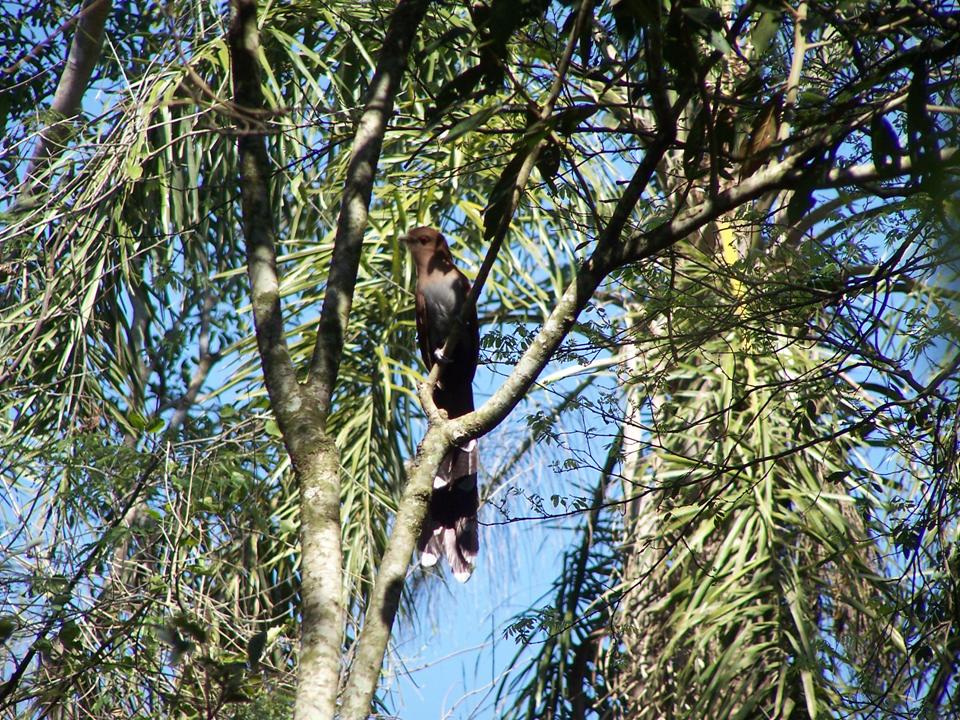
Designed by Paul Smith 2006. This website is copyrighted by law.
Material contained herewith may not be used without the prior written permission of FAUNA Paraguay.
Photographs on this web-site were taken by Paul Smith, Hemme Batjes, Regis Nossent,
Alberto Esquivel, Arne Lesterhuis, Rebecca Zarza and Hugo del Castillo and are used with their permission.
















